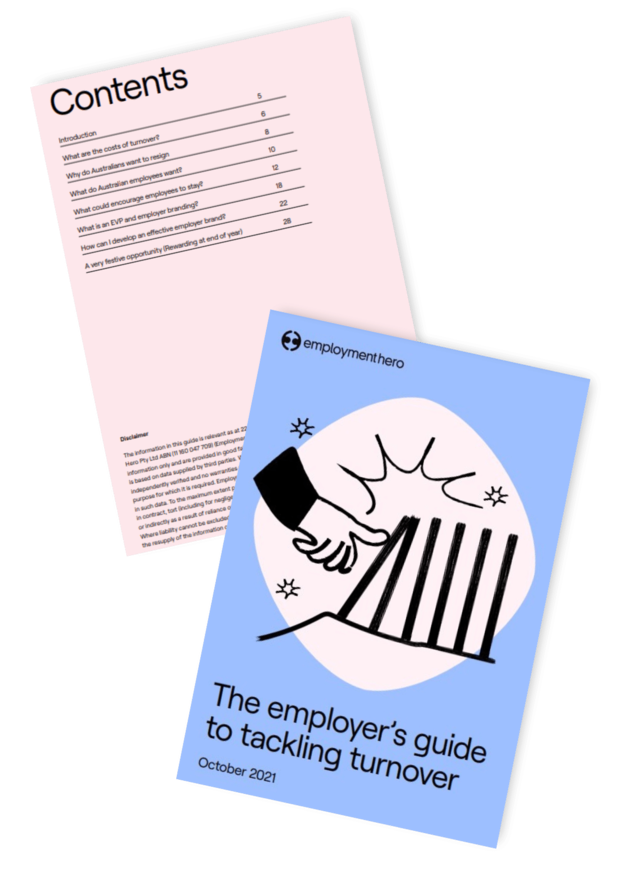Unauthorised Absence From Work: A Complete Guide
Absences that aren’t authorised can disrupt productivity & morale. Learn to manage them effectively, comply with employment law & prevent future issues.

Absence is a normal part of working life. We all get sick, face emergencies or need time off. But what happens when an employee doesn’t show up without explanation?
Unauthorised absence can throw a spanner in the works, but every UK employer faces this challenge at some point. The good news? You can tackle it head-on with the right strategy. They impact productivity, disrupt workflows, team morale and can cost your business time and money.
But with the right approach, you can tackle unauthorised absence effectively while staying compliant with UK employment law.
At Employment Hero, we’re here to simplify HR for UK businesses. In this guide, we’ll break down everything you need to know about unauthorised absences, including how to manage them fairly, prevent repeat issues, support your team with clear policies and leverage HR tools.
What is an unauthorised absence?
An unauthorised absence is any time an employee is absent from work without prior approval or a valid reason. In simple terms, it’s when someone doesn’t turn up and you don’t know why.
These absences may seem sudden, but they’re not always random. Understanding what they are and why they happen is the first step to managing them effectively.
Let’s make the difference clear:
- Authorised absences are approved by the employer or covered by law, like annual leave, certified sick leave, maternity/paternity leave, or time off for dependents.
- Unauthorised absences happen when the employee fails to follow absence procedures or doesn’t provide a valid explanation for their time away.
Common causes of unauthorised absence from work
Unauthorised absences are often a signal that something deeper is going on. Rather than jumping straight to discipline, it’s worth taking a step back and understanding what’s driving the behaviour. There are a number of reasons for an unauthorised absence from work, including:
Personal Issues
Life outside of work can take its toll, from burnout to anxiety, depression and financial stress to name a few. An employee’s personal issues may have a great impact on them, and they may not feel safe sharing this, resulting in them staying silent on the matter. This can lead to unauthorised absences, seemingly coming from out of the blue.
Family emergencies
Unexpected family emergencies, such as a child’s illness, a partner’s accident, or a sudden need to care for a relative, can cause employees to miss work at short notice. If they’re unsure of the correct reporting process or feel unable to communicate the situation, these absences can easily go unreported and become unauthorised.
Workplace disputes or dissatisfaction
If an employee feels unsupported, undervalued, or in conflict with a manager, disengagement can lead to absenteeism. They may avoid work altogether rather than face the situation.
Lack of clear absence policies
When leave policies are vague or poorly communicated, employees may be unsure about how to request time off correctly. Without clear guidance, small oversights can quickly turn into unauthorised absences, simply because the process wasn’t understood or followed.
Health and medical reasons without proper notification
It’s not uncommon for employees to assume that a short-term illness, like a 24-hour bug or headache, doesn’t require formal reporting. But without notifying their manager or following your absence procedure, even a one-day sick leave can be classed as unauthorised. Clear communication around expectations helps prevent these misunderstandings and encourages employees to report absences the right way.
How many unauthorised absences are allowed from work?
There’s no set legal limit on how many unauthorised absences an employee can have, and UK employment law doesn’t define a specific number. Instead, it leaves it up to individual employers to establish fair and consistent policies.
But that doesn’t mean the issue should be left open-ended.
To manage unauthorised absences effectively, your business needs a clearly defined framework. This should be outlined in your employment contracts, employee handbook, or absence policy, and should include:
- What qualifies as unauthorised absence.
- The process for reporting all absences, including short-term illness.
- The threshold for disciplinary action (e.g. after two or three instances within a certain period).
- How repeat absences are monitored, for example, using the Bradford Factor or another tracking system.
Creating defined limits allows you to take consistent action when policies aren’t followed and gives employees a clear understanding of what’s expected.
Keep in mind that flexibility and fairness are just as important as structure. If there’s a valid reason behind the absence, such as a family emergency or mental health issue, it should be considered before moving toward disciplinary measures. The goal is to balance accountability with empathy and having a clear process in place makes that much easier.
Employer responsibilities and legal considerations
Even when an absence is unauthorised, employers can’t simply jump to disciplinary action or dismissal. Employees are protected by employment law, and your business has a legal obligation to handle absence issues fairly and consistently.
Under the Employment Rights Act 1996, employees have the right not to be unfairly dismissed. This applies even in cases of unauthorised absence. If you terminate someone’s employment without following a fair and reasonable process, or if your response is considered disproportionate, you could face an employment tribunal for unfair or wrongful dismissal.
You must act reasonably when managing absence-related conduct. That means:
- Investigating the absence before taking action.
- Allowing the employee to explain.
- Following your internal policies and disciplinary process.
- Applying consistent standards across the business.
Failing to follow this process could lead to claims of unfair or wrongful dismissal.
Consequences of unauthorised leave
When an employee is absent without warning or explanation, the effects can be felt across the business. While it may seem like a one-off issue, unauthorised leave often creates knock-on challenges — impacting everything from team morale to project timelines. Understanding the consequences helps employers respond appropriately and put proactive measures in place to reduce future disruption.
Decreases productivity
When an employee is unexpectedly absent, the immediate impact is a disruption in workflow. Tasks are delayed, meetings rescheduled, and deadlines pushed back. But the longer-term effects on productivity can be even more significant. This can include:
- Workflow disruption.
- Reduced output.
- Inefficient time use.
- Unbalanced workloads.
Impacts team morale
Unauthorised absences can significantly harm team morale. When a colleague is unexpectedly out, their workload often falls onto others, leading to increased stress, longer hours, and potential burnout for the remaining team. This can foster feelings of unfairness among reliable employees who see a lack of accountability. Ultimately, such absences erode trust and cohesion, creating a negative atmosphere that signals a decline in expected standards and overall engagement.
Potential for disciplinary action
As an employer, when you encounter an unauthorised absence from an employee there are formal disciplinary steps you can take in response. You may choose to do this particularly if it’s repeated, prolonged or if they fail to provide a satisfactory explanation or follow procedures.
Remember, any disciplinary action must be fair, consistent, and fully compliant with UK employment law and your own policies.
Warnings
Warnings are usually the initial formal steps in a disciplinary process for unauthorised absence, serving as a formal record and a clear communication of the required improvement.
- Verbal warning: Often the first step for a minor or first-time unauthorised absence. It’s usually documented even though it’s “verbal,” detailing the issue, the policy broken, and the expected improvement. The employee is informed that a repeat occurrence could lead to a more formal warning.
- First written warning: Issued if the unauthorised absence reoccurs after a verbal warning, or if the initial absence is more serious. This is a formal letter outlining:
- The specific unauthorised absence(s).
- The company policy that has been breached.
- The consequences of further breaches (e.g., a final written warning).
- The period the warning will remain “live” on their record.
- The employee’s right to appeal the decision.
- Final written warning: A serious step, typically issued for persistent unauthorised absences despite previous warnings, or for a very severe single instance. This warning indicates that any further breach of absence policy could lead to dismissal. It also outlines the same details as a first written warning, including the right to appeal.
Dismissals
Dismissals are the ultimate and most severe consequence for unauthorised absence. Reserved for cases where prior warnings have been ineffective, the absence is extremely severe, or constitutes gross misconduct.
- Gross misconduct: In certain severe cases, such as an employee disappearing for an extended period without any contact, or repeatedly failing to turn up for critical work after multiple warnings, unauthorised absence can be classified as gross misconduct. This can lead to summary dismissal (dismissal without notice) if the company’s disciplinary procedure is rigorously followed.
- Other misconduct: For less serious misconduct, a period of notice (or a payment in lieu of notice) will be appropriate when dismissing an employee due to unauthorised absence.
- Risks of unfair dismissal claims: Failing to follow a fair process or having an unreasonable reason for dismissal can lead to an employee claiming unfair dismissal at an Employment Tribunal, which can result in significant financial penalties and reputational damage for the employer. Employees can generally only claim unfair dismissal once they have two or more years service.
How to handle unauthorised absence effectively
Handling unauthorised absence is often a delicate matter, requiring a nuanced approach. When an employee fails to turn up for work without prior notification or a valid explanation, the immediate reaction might be concern or frustration. However, it’s best to avoid jumping to conclusions and, instead, focus on balancing fair process and accountability with empathy.
Adhering strictly to UK employment law throughout this process is paramount to protect both the business and the employee’s rights, ensuring a consistent, proportionate, and legally sound response. There are certain steps to take to handle absence effectively:
- Contact the employee as soon as you’re aware of their absence.
- Record the absence and communication attempts.
- Hold a return-to-work interview to help understand what happened, clarify expectations and offer support.
- Decide next steps based on your policy. This might mean taking no further action, issuing a warning or triggering your disciplinary process.
- Monitor for recurrence, particularly if you notice patterns (e.g. frequent Monday absences).
Preventing unauthorised leave in the workplace
Prevention starts long before an absence occurs. By putting proactive measures in place, employers can significantly reduce the likelihood of unauthorised leave incidents, fostering a more reliable and engaged workforce. This isn’t just about avoiding problems; it’s about building a robust and supportive work environment.
- Build a clear and accessible absence policy
A clear, comprehensive, and easily understood absence policy is your first line of defence. Vagueness can lead to unauthorised absences simply because employees are unsure of correct procedures. Your policy should explicitly cover:
- How to report absence: Who to contact, when, and by what method.
- Authorised vs. unauthorised: Clear examples and definitions.
- Required documentation: When fit notes or other supporting documents are needed.
- Consequences of non-compliance: What happens if procedures aren’t followed.
Make this policy effortlessly accessible, perhaps on your intranet or HR platform, and review it during onboarding. Regular reminders help reinforce understanding.
- Foster a culture of openness and support
Many unauthorised absences stem from personal struggles employees feel unable to share. Creating a safe environment where staff feel comfortable discussing challenges before they escalate is a powerful preventative measure.
- Encourage proactive communication: Implement mechanisms like regular check-ins or anonymous feedback to encourage employees to discuss stress or personal difficulties.
- Provide support services: Invest in and promote wellbeing initiatives such as Employee Assistance Programmes (EAPs) or mental health first aiders. When employees feel supported, they’re less likely to disappear in a crisis.
- Manager training: Equip managers to identify signs of struggle, handle sensitive conversations, and signpost resources.
- Leverage digital leave management tools
Modern HR technology simplifies absence management, making it easier for employees to follow procedures and for you to track leave effectively.
- Streamlined processes: Tools like Employment Hero’s Leave Management Software allow employees to request time off quickly and automate approval workflows, reducing administrative burdens and common excuses.
- Accurate tracking & analytics: These platforms automatically track absences, providing comprehensive data. They can flag patterns of absence early, helping you identify and address potential issues proactively.
- Compliance & efficiency: By automating tasks, digital tools free up HR time and ensure processes align with UK compliance requirements.
When you make your leave system simple and transparent, employees are far more likely to use it correctly.
- Offer flexibility where you can
A rigid work environment can push employees toward unauthorised absence when personal needs clash with strict schedules. Offering reasonable flexibility can be a powerful preventative tool.
- Flexible hours & remote work: Allowing discretion over start/end times or offering remote options (where feasible) helps employees manage personal commitments and reduce stress without taking full days off.
- Time-off-in-lieu (TOIL): A system for accruing TOIL for extra hours worked gives employees a tangible way to gain time off, reducing the need for unexpected absences.
Streamline your absence management with Employment Hero
Bringing all these strategies together might seem like a large undertaking, but the right tools can simplify the process significantly. By focusing on clear communication, fostering a supportive environment, and embracing modern HR technology, UK businesses can transform the challenge of unauthorised absence into an opportunity to build a more resilient, engaged, and legally compliant workforce.
Discover how Employment Hero’s Employment Operating System can provide robust policies, seamless leave tracking, the compliance support you need to handle absence effectively, proactively prevent issues, and foster a thriving workplace.
Disclaimer: The information in this article is current as at June 2025, and has been prepared by Employment Hero UK Ltd and its related bodies corporate (Employment Hero). The views expressed in this article are general information only, are provided in good faith to assist employers and their employees, and should not be relied on as professional advice. Some information is based on data supplied by third parties. While such data is believed to be accurate, it has not been independently verified and no warranties are given that it is complete, accurate, up to date or fit for the purpose for which it is required. Employment Hero does not accept responsibility for any inaccuracy in such data and is not liable for any loss or damages arising directly or indirectly as a result of reliance on, use of or inability to use any information provided in this article. You should undertake your own research and seek professional advice before making any decisions or relying on the information in this article.
Related Resources
-
 Read more: Workplace Trends for 2026: What’s Shaping The Future of Work
Read more: Workplace Trends for 2026: What’s Shaping The Future of WorkWorkplace Trends for 2026: What’s Shaping The Future of Work
AI & automation, micro-learning and trust are shaping the new year. Explore the essential strategies to build a resilient, future-ready…
-
 Read more: Blue Monday: Make It the Most Productive Day of the Year for Your Team
Read more: Blue Monday: Make It the Most Productive Day of the Year for Your TeamBlue Monday: Make It the Most Productive Day of the Year for Your Team
Turn Blue Monday around. Discover how your business can transform the year’s most depressing day into a boost of positivity…
-
 Read more: NEW DATA REVEALS TRUE IMPACT OF NATIONAL INSURANCE HIKE ON SMES
Read more: NEW DATA REVEALS TRUE IMPACT OF NATIONAL INSURANCE HIKE ON SMESNEW DATA REVEALS TRUE IMPACT OF NATIONAL INSURANCE HIKE ON SMES
NIC changes will cost medium SMEs £18,000 annually. New analysis shows firms with >8 employees face steep costs, while Midlands…





















